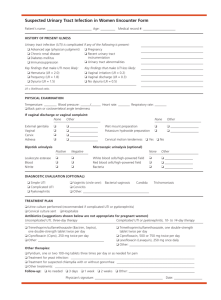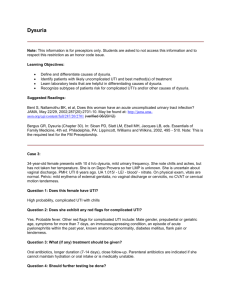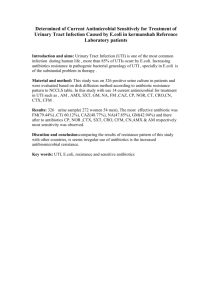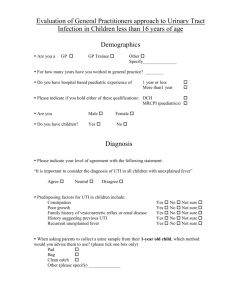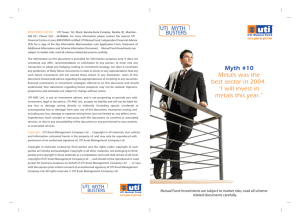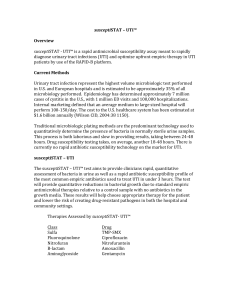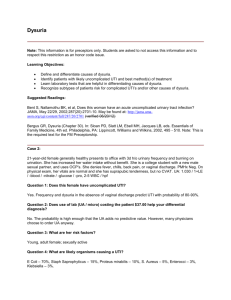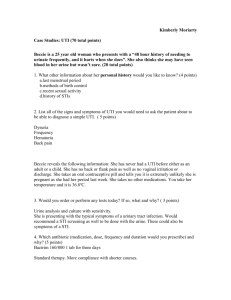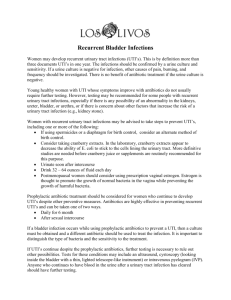Mid Cap Fund - UTI Mutual Fund
advertisement
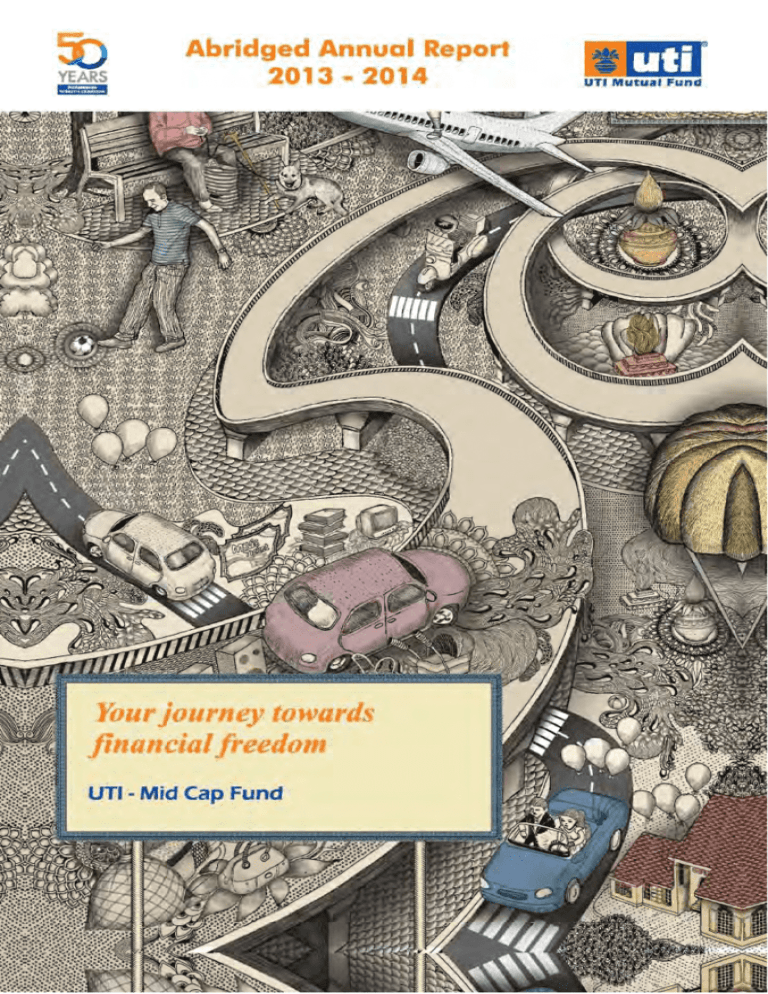
Eleventh Annual Report of the Trustees of UTI Mutual Fund for the year ended 31st March, 2014 The Trustees of the UTI Mutual Fund are pleased to present the Eleventh Annual Report and audited financial statements of the schemes of UTI Mutual Fund for the year ended 31st March, 2014. UTI Mutual Fund (UTI-MF) is one of the largest mutual funds in the country. It is a professionally managed Mutual Fund with high quality manpower across Fund Management, Operations and Sales & Marketing. The Average Assets Under Management (AAUM) of UTI-MF for the quarter ended 31st March, 2014 were Rs. 74,234 crores as against Rs. 69,450 crores for the quarter ended 31st March, 2013 showing an increase of 6.89%. I. (a) Schemes and Performance As of March 31, 2014 there were115 Schemes/Plans offered by the UTI-MF, out of which 26 were equity funds; 81 were income funds; 2 were liquid funds; and 6 were balanced/hybrid funds. During the period, 47 Income Schemes were launched which mobilised funds of Rs.8,415.30 crore. On the other hand, 22 debt schemes matured or were terminated. The total dividend paid out by all the schemes during the financial year 2013-14 was Rs. 1662.40 crore. Past performance is not indicative of future results. The objective of the fund management in UTI Mutual Fund is to deliver stable and consistent returns in the medium to long term, with a fairly lower level of volatility compared to the broader market. Rigorous in-house research, a process-based approach to investment management, and a focus on asset allocation and sector selection along with stock selection, are undertaken in the endeavour to consistently remain in the top quartile of the peer group of funds. Performance of the Scheme for the year ended March 31, 2014 under UTI - MID CAP FUND - AN OPENENDED EQUITY ORIENTED SCHEME Period Fund performance Vs Benchmark NAV CNX Mid CNX Nifty (%) Cap Index (%) (%) 16.36 17.98 43.28 -4.02 7.31 2.89 -4.09 -9.23 -1.2 14.35 13.77 17.28 Growth of ` 10000 NAV CNX Mid CNX Nifty (`) Cap Index (`) (`) 14328 11636 11798 10289 9598 10731 9880 9591 9077 49124 38156 36267 31.03.2011 - 31.03.2012 31.03.2012 - 31.03.2013 31.03.2013 - 31.03.2014 Since inception (7-Apr-04) as on 31st Mar., 2014 The above value is calculated on the return from Growth Option of the Scheme. Assuming that all payouts during the period have been reinvested in the units of the scheme at the immediate ex-div NAV. Returns are computed on the basis of “Compounded Annual Growth Rate” N.A. - Not Available *Compounded annualized Growth Rate. Schemes in which dividend was declared during year ended March 31, 2014 Dividend Declared under UTI - MID CAP FUND - AN OPEN-ENDED EQUITY ORIENTED SCHEME during the year ended March 31, 2014. Category Option Record Date Rate of Dividend Disclaimer: Pursuant to payment of Dividend/issue of Bonus units, the NAV of the respective Options of the Schemes would fall to the extent of payout and statutory levy (if applicable) 1 2nd Proof Final - File : 160 Mid Cap _OrientPM - 16 - 7 - 2014 Ib Future Outlook (a) Equity Market Nifty Index registered a 7% return for Financial Year 13, On surface this appears to have been a benign year for equities with a modest double-digit return. The year, in actual, was as volatile, as equity markets have been over the last five years. During the year, there were two intermediate moves of 10%, and another two moves in the region of 7-9%. Outlook for Financial Year 2014-15 The Nifty Index closed Financial Year 2013-14, with a sustained up move, at an all time high of 6,704. The move capped a positive run for two successive fiscal years. The market movement during Financial Year 2013-14 had three phases – April 2013 to May 2013: hope for RBI rate cut; May 2013 to September 2013: uncertainties on account of winding up of Federal Reserve Bank’s (USA) Quantitative Easing program leading to a sharp depreciation in the Indian Rupee; September 2013 to March 2014 - Stabilization on the currency front and a pre-election rally. As can be visualized, in each phase select sectors outperformed and few consistently outperformed the market in each of the phases. The key highlights of Financial Year 2013-14 were: l For the third year in succession, US market outperformed emerging markets (and India), with the S&P 500 registering a growth of 19.86%. Unlike Financial Year 2012-13, Europe (Euro Stoxx 50) and Japan (Topix) topped S&P 500 returns for the year. Brazil, China, Turkey and South Africa amongst emerging markets continued to struggle, underperforming India. l This was reflected in Foreign Institutional Investors (FII) flows as well, overall flows into emerging markets (EMs) were negative, net equity inflows totaled $14 Billion, as against $24 Billion in the previous fiscal. l FII proportion of free float of S & P BSE Sensex touched 49.2%, an all time high, as compared to Domestic Institutional Investors’s (DII) proportion of free float at 23.4%. l Market Cap to Gross Domestic Product (GDP) was 66%, lower than its historic average of 69% and way below the peak of 108% in Financial year 2007-08. l As per EPFR Global Inc (Emerging Portfolios Flow Research), which tracks flows into funds globally, EMs during Calendar Year 2013 have registered an outflow of $12 billion versus an inflow of $24 billion in Calendar year 2012. For Q1 Calendar year 2014, outflows have already touched $11 billion. l Mutual funds remained net sellers of equity with an outflow of Rs.27.05 billion for the financial year 2013-14. l India’s GDP growth during the year is estimated to touch 4.7% by the end of March 2014 as against 4.6% for Financial Year 2012-13. Agricultural sector is expected to register a growth of 4.6%, is the key driver for the marginal improvement in economic growth over Financial Year 2012-13. l Amongst the sectors, Autos (33.9%); Capital Goods (31.0%); Healthcare ( 24.7%); IT services (27.2%) outperformed the Nifty, while Banks (11.1%); Oil & Gas (13.4%) and Realty (-21.7%) underperformed, Fast Moving Consumer Goods (FMCG) performed in line. l Mid caps came back strongly in the second half of the year, though still underperforming the NIFTY for the year (15.0%). 2 Final - File : 160 Mid Cap _OrientPM - 16 - 7 - 2014 2nd Proof Elections and Market Unlike the US, India has a limited history to compare of elections and market movement. The table below depicts the Nifty Index movement for the previous five elections. Election Resulte date Market Levels Market Return 09-May-96 180 days Prior to Election 949 Election Result day 1,091 30 days Post Election 1,141 180 days Prior to Election 15% 02-Mar-98 1,135 1,098 1,150 -3% 07-Oct-99 993 1,470 1,370 48% 13-May-04 1,563 1,718 1,481 10% 16-May-09 2,800 3,672 4,484 31% 16-May-14 5,907 6694+ 13% 13% Comments 30 days Post Election 5% Inspite of positive election outcome, market gave marginal return post election, at it was trading at 52 week high 5% Market moved in opposite directions during pre/post election -7% Market at 52 week high, corrected post elections after disppointing election outcome. -14% Market corrected sharply, as unfavorable election outcome led to coalition government. 22% Pre-election rally driven by recovery from global financial crisis and not domestic factor + Markets at 52 week high & rallied pre election on hopes of changes in Government + Closing price as of 4th April 2014 # Election result to be concluded Market Outlook Among the key Global factors which could impact emerging markets like India, would be: the impact of US Fed unwinding its Quantitative Easing (QE) programme, the impact of “Abenomics” in Japan, China’s economic growth rate, and the revival of growth in Europe, albeit at a tepid pace. Emerging economies like Brazil, Turkey, South Africa and Indonesia, like India, will have general elections and election results could also impact these markets during Financial year 2014-15. With DIIs outflows over the last four fiscal years, FIIs have been the key bulwark , purchasing $96 billion of Indian equities. The significance of this number is reflected when compared to the total FII flows of $150 billion since opening up the Indian markets in the mid 1990s. We believe, a strong pro-active Government at the Centre, post elections, could be a key positive for equities as an asset class over the medium term. This could reverse the trend of DII outflows, registered over the last four years. A fear of an El Nino impacting monsoon, sticky inflation impacting the pace at which RBI could cut interest rates (to revive the investment cycle) and sluggish economic revival could act as a dampener to the positive undertone in the market currently. Gross Domestic Product (GDP) growth for Financial year 2014-15 are estimated at 5.4%, signaling a revival of the Indian economy, are based on the forecast of a normal monsoon, which could be under threat in case of a below-normal monsoon, impacted by El Nino. The Nifty Index has registered an earnings growth of 13-14% for the period 1995-2013. For the last two fiscal years, the earnings growth rate has been lower than this long term trend. For Financial year 2014-15, as per Bloomberg consensus, Nifty Index earnings are expected to grow by 15.1%, translating to a yearend Earnings Per Share (EPS) of Rs.470, with a P/E of 15-15, this translates into a fiscal year-end target of 7,200-7300. A key risk to this, modest, year-end target could be a stronger than expected election mandate, an above average monsoon and a sharper than expected upswing in the economic growth following a change of Government. 3 2nd Proof Final - File : 160 Mid Cap _OrientPM - 16 - 7 - 2014 (b) Debt Market Outlook: Global economy: Global economic activity, which strengthened during 2013, is expected to continue on its path towards a gradual recovery led by advanced economies, especially the US. However, the expectation of recovery is tempered by downside risks emanating from ongoing tapering of Quantitative Easing (QE) by the US Federal Reserve (Fed), deflation concerns and fragile economic recovery in the Euro area and moderation of growth along with concerns over rapid credit expansion in China. While the emerging markets have weathered the initial phase of QE tapering quite well, capital flows to emerging economies could remain volatile during 2014 if there are any unexpected variations in the pace of withdrawal of monetary stimulus. Countries with higher inflation and wider current account deficits are more vulnerable. Indian Economy: India’s GDP growth, which bottomed at 4.4% in Q1 Financial Year 2014, has shown signs of modest improvement during Q2 & Q3 Financial Year 20 14 to 4.8% and 4.7% respectively. The recovery, which has largely been supported by agriculture growth, remains feeble given that there are no signs of pick-up in manufacturing activity. The Index of Industrial Production (IIP) has remained stagnant during the past 24 months due to subdued investment and consumption demand. The gross fiscal deficit and primary deficit were both lower than Budget Estimate by 0.2 percentage points each at 4.6% of GDP and 1.3% of GDP respectively. The fiscal correction was largely achieved by a sharp cutback in plan expenditure as gross tax collections recorded a shortfall of 6.2 percent (compared to BE) due to the general slowdown. While fiscal deficit targets were met in FY14, the quality of fiscal correction needs significant improvement especially towards curtailment of subsidies and lowering dependence on adhoc inflows such as dividends from banks & public sector undertakings to achieve the fiscal target. Current Account Deficit (CAD) for fiscal year 2013-14 is expected to drop significantly over the previous fiscal year largely on account of a decline in imports by 8% during FY14. Imports contracted for nine consecutive months primarily led by a sharp decline in non-oil imports (declined by 13% during Financial Year 2014) led by gold imports on account of Government and RBI restrictions on import of gold. A gradual recovery in key partner economies and depreciation of the INR led to a modest recovery in exports which grew by 4% during FY14. Going forward, with a likely recovery in global growth, exports are likely to maintain their growth momentum during 2014-15. The RBI’s swap windows for mobilization of fresh Foreign Currency Non Resident (B) deposits and bank tier-1 capital led to a surge in capital flows and consequent increase in forex reserves during September-November 2013. The reserves increased by USD 23 billion between August 2013 and March 2014. The rupee, which came under immense pressure during May 2013-August 2013 period on account of QE tapering indications by the Fed, has since November 2013 moved in a narrow band of Rs 60-Rs. 63 per USD. Inflation, as measured by the Consumer Price Index (CPI) declined during the period from December 2013 (9.87%) to February 2014 (8.03%) largely driven by moderation in food prices. However, in the absence of any significant supply side policy intervention, risks to inflation are largely on the upside emanating from an adverse outcome on the monsoon, higher commodity prices on account of geopolitical risks and sharper than anticipated tapering that could lead to exchange rate pressures. With the narrowing of the twin deficits, rebuilding of forex reserves and inflation-targeting stance of the RBI, near term risks to macro-economic stability have diminished. However, much more efforts are needed towards removing structural bottlenecks in the food supply chain, re-building business confidence to support investments and creating sustainable fiscal space. The outcome of the General Elections and subsequent policy actions would be critical in this regard. Fixed Income Outlook: Despite fall in aggregate demand, headline CPI continued to remain high and sticky which compelled RBI to neutralize the policy rates by hiking the rates by 75 basis points since May-13. For Financial Year 2015, a range of factors would determine the trend in policy rates viz. fiscal policy and discipline of the new government, monsoon and its impact on food inflation and global perspective towards EM rates/currency/ratings. Deviation of headline CPI (especially core CPI) from the RBI trajectory i.e. 8% by Financial Year 2014 and 6% by Financial Year 2015 amid fears of inflation targeting would be closely monitored by the market. 4 Final - File : 160 Mid Cap _OrientPM - 16 - 7 - 2014 2nd Proof (c) Operations of the schemes Investor Reach and Distribution As on 31st March, 2014, UTIMF had 9.56 million investor folios. UTI Mutual Fund has always been proactive in its communication with its investors on announcements, services etc. through various mediums. The online transaction facility over the internet and the mobile media has been revamped and enhanced. Investors can now generate their own Personal Identification Number (PIN), after going through security validation. Further, investors can register for Systematic Investment Plans (SIP) electronically (i-SIP). Similarly, Investors now have the convenience of doing purchase transactions over mobile phone anytime, anywhere. II. Brief background of Sponsors, Trust, Trustee Company and Asset Management Company a. UTI Mutual Fund UTI Mutual Fund (UTI MF) was set up as a Trust by the “Settlers”, State Bank of India, Life Insurance Corporation of India, Punjab National Bank and Bank of Baroda on 9th December, 2002 with UTI Trustee Company Private Limited (the Trustee Company) as Trustee in accordance with the provisions of the Indian Trust Act, 1882 and is duly registered under the Indian Registration Act, 1908. The Trustees have entered into an Investment Management Agreement on 9th December, 2002 with UTI Asset Management Company Ltd. (UTI AMC) to function as the Investment Manager for all the Schemes of UTI Mutual Fund. UTI Mutual Fund was registered with SEBI on 14th January, 2003. b. UTI Trustee Company Private Limited The Trustee is the exclusive owner of the Trust Fund and holds the same in trust for the benefit of the unit holders. The Trustees have been discharging their duties and carrying out the responsibilities as provided in the SEBI (MF) Regulations, 1996 and the Trust Deed. The Trustees seek to ensure that the Fund and the Schemes floated there under are managed by the UTI AMC in accordance with the Trust Deed, the Regulations, directions and guidelines issued by the SEBI, the Stock Exchanges, the Association of Mutual Funds in India and other regulatory agencies. The liabilities and responsibilities of the Trustees are as contained in the Trust deed dated 9th December 2002 and Regulation 18 of SEBI (MF) Regulations, 1996. The Trustees as on 31st March 2014 are Shri Ashok Kini, Shri S Ravi Prof. P G Apte, Prof. P V Ramana, Shri Ashok Kini is the Chairman of Trustee Company. c. Board of Directors The Board of Directors of UTI Trustee Company Pvt. Ltd. comprises of 4 Directors as on 31st March, 2014. All the Directors are Non-Executive Directors. Two are independent Directors and two are Associate Directors. The names of the Board members, their attendance at Board Meetings held during the year and the number of Directorships and Committee Chairmanships / Memberships held by them in other companies is given below (other directorships do not include alternate directorships, directorships of private limited companies, Section 25 companies and of companies incorporated outside India): Name of the Director No of Board Meetings No of Directorships in No of committee positions held in 2013-14 other public companies held in other public companies Held (during Attended Chairman Member Chairman Member their tenure) Mr. Ashok Kini 6 6 Nil 5 Nil Nil Mr. S. Ravi 6 5 Nil 8 Nil Nil Prof. P. G. Apte 6 5 Nil 1 Nil Nil Prof. P. V. Ramana 6 6 1 1 Nil Nil Mr. Janki Ballabh* 3 3 N.A. N.A. N.A. N.A. Mr. S. P. Oswal ** 4 2 N.A. N.A. N.A. N.A. * Resigned with effect from 1st August, 2013 ** Resigned with effect from 28th October, 2013. Six Board Meetings were held during the year and the gap between two meetings did not exceed three months. The dates on which the Board Meetings were held are as follows: April 26, 2013; June 5, 2013; August 1, 2013; October 28, 2013; December 18, 2013, and February 17, 2014. No Director has any material pecuniary relationship or transactions with UTI Trustee Company Pvt. Ltd. 5 2nd Proof Final - File : 160 Mid Cap _OrientPM - 16 - 7 - 2014 d. Audit Committee The Audit Committee of the Board comprises of two members. The composition is as under: Name of the Directors Designation Chairman of the Audit Committee Mr. S. Ravi Prof. P. G. Apte Member During the year, 4 meetings of the Audit Committee were held on 26th April, 2013, 16th August, 2013, 28th October, 2013 and 17th February, 2014. III. Investment objectives of the schemes, performance and policies UTI - MID CAP FUND - AN OPEN-ENDED EQUITY ORIENTED SCHEME The scheme aims to provide to investors growth of capital over a period of time as well as to make periodical distribution of income from investment in stocks of respective sectors of the Indian economy Investment objective is “capital appreciation” by investing primarily in mid cap stocks. The Fund would invest, at least 65% of its Net Assets in equity and equity related instruments issued by companies which are constituents of CNX Midcap Index or S&P CNX 500 but not a part of BSE Sensex (30) or Nifty (50), at the time of investment. Currently, companies having an annual average market capitalisation of less than `75 crores would not be considered for investment in the aforesaid portion of the portfolio, in line with the floor specified in the Benchmark CNX Mid Cap Index. This lower limit of `75 crores would change in line with the change in the lower limit of the market capitalisation criterion in the Benchmark. Further, no stocks, which are among the top 50 stocks in terms of market capitalisation, will form part of the aforesaid 65% of the net assets of UTI Mid Cap Fund, at the time of investment. Upto 35% of the Net Assets would be invested in equity and equity related instruments issued by companies with a potential for consistent growth and are relatively undervalued to their expected long-term earning growth. Not more than 20% of net assets will be invested in money market instruments. Subject to SEBI Regulations, the asset allocation pattern indicated above may change from time to time, keeping in view the market conditions, market opportunities, applicable regulations and political and economic factors. It must be clearly understood that the percentages stated above are only indicative and not absolute. These proportions may vary substantially depending upon the perception of the AMC; the intention being at all times to seek to protect the interests of the Unit holders. Such changes in the investment pattern will be for short-term periods on defensive consideration. The Quarterly Average Fund Size of the Scheme was Rs. 785.28 crore as on 31st March 2014. As at March 31, 2014, the Scheme had 94.60% of its net assets invested in equities and 5.40% in money market instruments / net receivables. IV. Annual Accounts of Schemes of UTI Mutual Fund The scheme-wise financial statements for the year 2013-14 are enclosed with the report of the auditors. Significant Accounting Policies form part of the Notes to Accounts, which are annexed to the Balance Sheet of Schemes. The financial statements, Notes to Accounts and accounting policies have been prepared in accordance with SEBI (Mutual Funds) Regulations, 1996 and exhibits true and fair view of the operating results. V. Unclaimed Dividend and Redemptions Unclaimed Dividend Unclaimed Redemption Amount in ` No. of Investors Amount in ` No. of Investors 32,821,793.28 23,322 13,582,396.10 931 VI. Statutory information The sponsors are not responsible or liable for any loss resulting from the operation of the Schemes of the Fund beyond their initial contribution of Rs. 10,000/- for setting up the Fund, and such accretions/additions to the same. The price and redemption value of the units, and income from them, can go up as well as down with fluctuations in the market value of its underlying investments. The Annual report of UTI Mutual Fund for the year ended on 31st March, 2014 is available at http://www.utimf. com and is also available for inspection at the Corporate Office at UTI Tower, ‘Gn’ Block, Bandra Kurla Complex, Bandra East, Mumbai – 400051. Present and Prospective unit holders can obtain copy of the trust deed, the full Annual Report of UTI Mutual Fund/ UTI Asset Management Company Ltd. on application, at a price. 6 Final - File : 160 Mid Cap _OrientPM - 16 - 7 - 2014 2nd Proof New Initiatives A. Online Initiatives 1. Quick Purchase: A facility called “Quick Purchase” has been introduced in UTI MF under online investment platform with effect from June 20, 2013, where all existing individual investors (numbering around 9.57 million) of UTI Mutual Fund can buy additional units in the same or different scheme / plan under his / her existing folio, with ease and convenience round the clock 24X7. The investors who are investing through this facility need not undergo any registration formalities, generate PIN or enter password. The investor needs to enter only Folio No, Permanent Account Number (PAN) & Bank Account Number for validation purpose. 2. Dividend Summary: Dividend Summary has now been enabled as a mail back service in our website with effect from 21st June 2013. The investor has to input the parameter PAN, select the financial year & mode of dispatch to get the Dividend Summary. The Dividend Summary is useful to investors while filing their IT returns. 3. invest@uti: Some of the new features have been added in our online investment portal (invest@uti) with effect from 21st March 2014. In addition to i-SIP registration, now registration of STRIP (Systematic Transfer Investment Plan) & SWP (Systematic Withdrawal Plan) can also be made online through our website. Cancellation of Systematic Investment Plan (SIP) can also be made online through our website. B. Value Added Services A. Enhancements in Pull SMS services : For the convenience of investors, enhanced Pull SMS facility has been introduced for Balance (BAL) & Net Asset Value (NAV) service apart from our existing services of ESoA, BAL <Folio No> & NAV service with effect from 4th July 2013. The investor will receive the information on their registered mobile number just by sending the pre-defined simple keywords to a dedicated short code 5607090. The following services are offered to the investors who have registered their mobile number with us: 1. BAL<PAN>: Under this service, the investor can receive the aggregate value of his / her investment. The investor need not remember the folio numbers where investment was made under multiple folios. 2. FOLIOBAL: This service provides the value of the outstanding units in rupee terms upto 3 folios. The investor need not remember the folio number and the information may be obtained on the go. For > 3 schemes, the investor has to SMS the keyword BAL <folio no>. 3. BAL <Scheme code> : Investor can receive the value of a specific scheme in which he / she has invested. The investor need not remember the folio number to avail this facility 4. FOLIONAV: This service provides the NAV of a specific scheme under the folio where units are live upto 3 schemes. The investor need not remember the scheme code to avail this facility. For > 3 schemes, the investor has to SMS the keyword NAV <Scheme code>. C. Transaction through SMS : Commercial Transactions on SMS (SMS2invest@uti) were introduced with effect from 3rd March 2014. Investor can Purchase, Redeem & Switch by sending SMS keywords to our short code number 5 60 70 90. One time registration form is required to be submitted. This facility is available for our existing Know Your Client (KYC) complied Individual Investors with mode of holding as “Single” or “Anyone or Survivor”. Mobile Numbers registered in India are eligible for this facility. 37 schemes are covered under this facility. Scheme short codes have been designed for the above referred schemes. D. Implementation of National Automated Clearing House (NACH) facility under SIP – ‘Express SIP’ The key features of the NACH are: a) it reduces the mandate registration time from 30 days to 14 days; b) It also eliminates the physical movement of mandate forms to destination bank branches; c) Confirmation of mandate registration is received across participating banks; and d) Unique mandate registration number (UMRN) is available for better tracking. E. Folio or Scheme Summary - Summary of Scheme wise value of investment has been incorporated in Account Statement with effect from 11th Dec 2013. Investors having single folio with multiple schemes can view the scheme summary on their Account Statement. F. Customized Birthday Mailers to Investors – Birthday emailers to investors have been commenced with effect from 6th Dec 2013. Emailers with differentiated creatives are being sent to investors who are below 18 years of age and 18 years & above. 7 2nd Proof Final - File : 160 Mid Cap _OrientPM - 16 - 7 - 2014 G. Hindi Account Statement enabled as a mail back service on our website with effect from 20th February 2014. Risk Factor Mutual funds, like securities investments, are subject to market and other risks and there can be no guarantee against loss resulting from investment in the Schemes nor can there be any assurance that the Scheme’s objectives will be achieved. Liability and Responsibility of Trustees and Settler The main responsibility of the Trustees is to safeguard the interest of the unit holders and, inter-alia, ensure that the UTI-AMC functions in the interest of investors and in accordance with the SEBI (Mutual Fund) Regulations, 1996; the provisions of the Trust Deed and the Scheme Information Document of the respective schemes. From the information provided to the Trustees and the review that the Trustees have undertaken, the Trustees believe that UTI AMC has operated in the interest of the unit holders. Acknowledgement The Trustees thank the investors for their continued support. We also thank the Government of India, the Securities and Exchange Board of India, Association of Mutual Funds in India, Reserve Bank of India, the Sponsors and the Board of UTI Asset Management Company Ltd. for their support, co-operation and guidance during the year. Our thanks are also to our Auditors, Custodian, Registrar and Transfer Agents, Banks, Distributors and service providers for their services. We value the contribution of the officers and employees of UTI-AMC in the progress of the UTI Mutual Fund. For UTI Trustee Company Private Ltd. Dated: 25th April 2014 Place : Mumbai sd/(Ashok Kini) Chairman 8 Final - File : 160 Mid Cap _OrientPM - 16 - 7 - 2014 2nd Proof The Statement on status of Redressal of Complaints received against UTI Mutual Fund during the financial year 2013-14 is annexed as Annexure 5 and forms part of Trustees’ report. Annexure 5 Complaint code IA IB IC ID II A II B II C II D III A III B III C III D III E IV Type of complaint# Non receipt of Dividend on Units Interest on delayed payment of Dividend Non receipt of Redemption Proceeds Interest on delayed payment of Redemption Non receipt of Statement of Account/Unit Certificate Discrepancy in Statement of Account Data Corrections in Investor Details Non receipt of Annual Report/Abridged Summary Wrong switch between Schemes Unauthorized switch between Schemes Deviation from Scheme attributes Wrong or excess charges/ load Non updation of changes viz. address, PAN, bank details, nomination, etc Others Total (a) No. of complaints pending at the beginning of the year Action on (a) and (b) 0 (b) No of complaints received during the year 209 0 Resolved Non Action30-60 60-180 Beyond able* days days 180 days Within 30 days Pending as on 16/04/2014 0-3 months 3-6 6-9 9-12 months months months 209 0 0 0 0 0 0 0 0 6 6 0 0 0 0 0 0 0 0 0 280 279 1 0 0 0 0 0 0 0 0 11 11 0 0 0 0 0 0 0 0 0 221 221 0 0 0 0 0 0 0 0 0 45 45 0 0 0 0 0 0 0 0 0 2618 2617 1 0 0 0 0 0 0 0 0 2 2 0 0 0 0 0 0 0 0 0 11 11 0 0 0 0 0 0 0 0 0 11 11 0 0 0 0 0 0 0 0 0 0 0 0 0 0 0 0 0 0 0 0 12 12 0 0 0 0 0 0 0 0 0 348 348 0 0 0 0 0 0 0 0 0 571 571 0 0 0 0 0 0 0 0 0 4345 4343 2 0 0 0 0 0 0 0 # including against its authorized persons/ distributors/ employees. etc. *Non actionable means the complaint that are incomplete / outside the scope of the mutual fund Voting Disclosure: The general voting policies and procedures of UTI Asset Management Limited for the Schemes of UTI Mutual Fund and the actual exercise of votes in the general meetings of all the investee companies for the financial year 2013-14 have been disclosed in our website (www.utimf.com) and in the full Annual Report of the Scheme for the financial year 2013-14.” 9 2nd Proof Final - File : 160 Mid Cap _OrientPM - 16 - 7 - 2014 INDEPENDENT AUDITORS’ REPORT To the Trustee of UTI Mutual Fund Report on the Financial Statements We have audited the accompanying financial statements of the schemes UTI - MID CAP FUND - AN OPEN-ENDED EQUITY ORIENTED SCHEME of the UTI Mutual Fund, which comprise the Balance Sheets as at March 31, 2014 and the Revenue Accounts for the year/period then ended and a summary of significant accounting policies and other explanatory information. Management’s Responsibility for the Financial Statements Trustee of UTI Mutual Fund and UTI Asset Management Company Limited are responsible for the preparation of these financial statements that give a true and fair view of the financial position and financial performance of the Schemes in accordance with the accounting policies and standards as specified in the Ninth Schedule of the Securities and Exchange Board of India (Mutual Funds) Regulations, 1996 and amendments thereto (“the Regulations”). This responsibility includes the design, implementation and maintenance of internal control relevant to the preparation and presentation of the financial statements that give a true and fair view and are free from material misstatement, whether due to fraud or error. Auditors’ Responsibility Our responsibility is to express an opinion on these financial statements based on our audit. We conducted our audit in accordance with the Standards on Auditing issued by the Institute of Chartered Accountants of India. Those Standards require that we comply with ethical requirements and plan and perform the audit to obtain reasonable assurance about whether the financial statements are free from material misstatement. An audit involves performing procedures to obtain audit evidence about the amounts and disclosures in the financial statements. The procedures selected depend on the auditors’ judgment, including the assessment of the risks of material misstatement of the financial statements, whether due to fraud or error. In making those risk assessments, the auditor considers internal control relevant to the Scheme’s preparation and fair presentation of the financial statements in order to design audit procedures that are appropriate in the circumstances, but not for the purpose of expressing an opinion on the effectiveness of the Scheme’s internal control. An audit also includes evaluating the appropriateness of accounting policies used and the reasonableness of the accounting estimates made by management, as well as evaluating the overall presentation of the financial statements. We believe that the audit evidence we have obtained is sufficient and appropriate to provide a basis for our audit opinion. Opinion In our opinion and to the best of our information and according to the explanations given to us, the aforesaid financial statements give the information required by the Regulations as applicable and give a true and fair view in conformity with the accounting principles generally accepted in India: (a) in the case of the Balance Sheets, of the state of affairs of the Scheme as at March 31, 2014; and (b) in the case of the Revenue Accounts, of the surplus/deficit, as applicable for the year/period ended on that date. Emphasis of Matter We draw attention to Note II(A) in Schedule 9 of the financial statements wherein the management of UTI Asset Management Company Limited has explained its rationale regarding Accounting Standards issued by the Institute of Chartered Accountants of India as not being applicable to the Schemes of UTI Mutual Fund. Our opinion is not qualified in respect of this matter. Report on Other Legal and Regulatory Requirements As required under the Regulations, we report that: 1. We have obtained all the information and explanations which to the best of our knowledge and belief were necessary for the purpose of our audit; 2. The Balance Sheets and the Revenue Accounts dealt with by this Report are in agreement with the books of account of the Schemes; 3. In our opinion, the Balance Sheets and the Revenue Accounts dealt with by this report have been prepared in accordance with the accounting policies and standards as specified in Ninth Schedule of the Regulations. 4. The methods used to value non traded securities, as determined by UTI Asset Management Company Limited and as approved by the Trustee of UTI Mutual Fund are in good faith and in accordance with the guidelines for valuation of securities for mutual funds as mentioned in the Eighth Schedule of the Regulations issued by the Securities and Exchange Board of India, and are fair and reasonable. For Haribhakti & Co. Chartered Accountants Firm Registration No. 103523W Sd/Chetan Desai Partner Membership No. 17000 Mumbai: April 25, 2014 10 Final - File : 160 Mid Cap _OrientPM - 16 - 7 - 2014 2nd Proof ABRIDGED REVENUE ACCOUNT FOR THE YEAR / PERIOD ENDED 31ST MARCH 2014 ` in Lacs UTI - MID CAP FUND Current Previous Year / Period Year / Period ended 31.3.2014 ended 31.3.2013 1 1.1 1.2 1.3 1.4 1.5 1.6 1.7 INCOME Dividend Interest Realised Gain / (Loss) on Foreign Exchange Transactions Realised Gains / (Losses) on Interscheme sale of investments Realised Gains / (Losses) on External sale / redemption of investments Realised Gains / (Losses) on Derivative Transactions Other Income 2 2.1 2.2 2.3 2.4 2.5 2.6 2.7 2.8 2.9 EXPENSES Management fees Service tax on Management fees Transfer agents fees and expenses Custodian fees Trusteeship fees Commission to Agents Marketing & Distribution expenses Audit fees Other operating expenses * 3 4 5 6 7 7.1 7.2 7.3 8 9 9.1 9.2 10 (B) NET REALISED GAINS / (LOSSES) FOR THE YEAR / PERIOD (A -B = C) Change in Unrealised Depreciation in value of investments (D) NET GAINS / (LOSSES) FOR THE YEAR / PERIOD (E = (C-D)) Change in unrealised appreciation in the value of investments (F) NET SURPLUS / (DEFICIT) FOR THE YEAR / PERIOD (E + F = G) Add: Balance transfer from Unrealised Appreciation Reserve Less: Balance transfer to Unrealised Appreciation Reserve Add / (Less): Equalisation Total Dividend appropriation Income Distributed during the year / period Tax on income distributed during the year / period Retained Surplus / (Deficit) carried forward to Balance sheet (A) * includes Deferred Revenue Expenditure written off Notes to Accounts - Annexure I 384.73 85.81 32.97 784.83 85.93 1,374.27 408.35 100.78 (122.61) 2,105.26 9.43 12.56 2,513.77 409.18 50.57 39.12 2.43 0.12 112.96 35.25 0.17 36.67 686.47 687.80 687.80 10,335.82 11,023.62 (10,335.82) 5,376.86 (4,958.96) 375.56 46.73 31.97 3.43 0.13 153.52 20.45 0.40 92.11 724.30 1,789.47 1,789.47 (822.04) 967.43 822.04 (971.22) (149.18) 6,064.66 0.01 818.24 11 2nd Proof Final - File : 160 Mid Cap _OrientPM - 16 - 7 - 2014 ABRIDGED BALANCE SHEET AS AT 31ST MARCH 2014 ` in Lacs UTI - MID CAP FUND As at As at 31.3.2014 31.3.2013 LIABILITIES Unit Capital Reserves & Surplus Unit Premium Reserves Unrealised Appreciation Reserve Other Reserves Loans & Borrowings Current Liabilities & Provisions Provision for doubtful Income/Deposits Other Current Liabilities & Provisions TOTAL ASSETS 1 Investments 1.1. Listed Securities: 1.1.1 Equity Shares 1.1.2 Preference Shares 1.1.3 Equity Linked Debentures 1.1.4 Other Debentures & Bonds 1.1.5 Securitised Debt securities 1.2 Securities Awaited Listing: 1.2.1 Equity Shares 1.2.2 Preference Shares 1.2.3 Equity Linked Debentures 1.2.4 Other Debentures & Bonds 1.2.5 Securitised Debt securities 1.3 Unlisted Securities 1.3.1 Equity Shares 1.3.2 Preference Shares 1.3.3 Equity Linked Debentures 1.3.4 Other Debentures & Bonds 1.3.5 Securitised Debt securities 1.4 Government Securities 1.5 Treasury Bills 1.6 Commercial Paper 1.7 Certificate of Deposits 1.8 Bill Rediscounting 1.9 Units of Domestic Mutual Fund 1.10 Foreign Securities 1.11 Gold Total Investments 2 Deposits 3 Other Current Assets 3.1 Cash & Bank Balance 3.2 CBLO/ Reverse Repo Lending 3.3 Others 4 Deferred Revenue Expenditure (to the extent not written off) TOTAL Notes to Accounts - Annexure I 1 2 2.1 2.2 2.3 3 4 4.1 4.2 24,650.38 10,854.91 27,043.51 14,589.32 17,338.26 - (552.80) 4,253.50 11,273.60 - 2,557.20 86,178.67 517.49 26,346.70 78,995.25 - 24,597.00 32.90 - - - 104.79 79,100.04 5,707.20 268.55 24,898.45 1,232.78 1,371.43 - 215.47 - 86,178.67 26,346.70 12 Final - File : 160 Mid Cap _OrientPM - 16 - 7 - 2014 2nd Proof NOTES TO ACCOUNTS - ANNEXURE I TO THE ABRIDGED BALANCE SHEET AND REVENUE ACCOUNT FOR THE YEAR / PERIOD ENDED 31ST MARCH 2014 1 Investments:1.1 Investments of the Schemes are registered in the name of the Trustees for the benefits of the Schemes Unitholders. 1.2. Open Position of derivatives (outstanding market value & % to Net Assets as of the Year end): Nil 1.3. Investments in Associates and Group Companies Associates / Sponsors Nature of Instruments Market Value (` in Lakhs) as on 31st March 2014 1,159.99 1,134.29 229,210.95 Bank of Baroda Equity Shares LIC Housing Finance Ltd. Equity Shares Vardhman Textiles Ltd. Equity Shares Total Aggregate Investment by all scheme Market Value (` in Lakhs) as on 31st March 2013 309.94 374.45 204,964.67 1.4. Open position of Securities Borrowed and / or Lend by the scheme: Nil 1.5. Details of NPA: Aggregate market value and provision thereof (` in Lakhs) Nil 1.6. Aggregate Unrealised Gain / Loss as at the end of the Financial Year / Period and percentage to net assets. Current Year Asset Class Deprecation Previous Year Apprecation Net Amount ` In lakhs % to Net ` In lakhs % to Net Assets Assets Debenture and Bonds Equity Shares (1,878.53) (2.25) 16,467.85 Total (1,878.53) (2.25) 16,467.85 ` In lakhs Deprecation Apprecation - - 19.69 19.69 14,589.32 14,589.32 - - - 32.90 17.45 (4,107.76) (15.90) 17.45 (4,107.76) (15.90) 8,328.36 8,361.26 1.7. Aggregate Value of Purchase and Sale with Percentage to average assets. 2013-14 PURCHASE Net Amount % to Net ` In lakhs % to Net ` In lakhs % to Net ` In lakhs % to Net Assets Assets Assets Assets 0.13 32.90 0.13 32.24 4,220.59 32.37 4,253.50 16.34 16.47 (` In Lacs) 2012-13 SALE PURCHASE SALE Amount % Amount % Amount % Amount % 5,825.57 22.55 11,611.93 44.95 4,484.46 15.78 8,202.84 28.86 1.8. Non-Traded securities in the portfolio: Provide Aggregate Value of Equity, Debt & Money Market Instruments and percentage to net assets. Category Equity 31st March 2014 Market Value % to Net Assets (` in Lakhs) 104.79 0.13 31st March 2013 Market Value % to Net Assets (` in Lakhs) 268.55 1.04 13 2nd Proof Final - File : 160 Mid Cap _OrientPM - 16 - 7 - 2014 2. Details of Transaction with Associates under regulation 25 (8) SBI Bank Charges 2013-14 Name of Sponsor or its Nature of Association associate and employees or / relation their relatives State Bank of India Sponsor Period covered Bank Charges (` Lakhs) April 13 to March 14 0.58 Period covered Bank Charges (` Lakhs) April 12 to March 13 1.10 SBI Bank Charges 2012-13 Name of Sponsor or its Nature of Association associate and employees or / relation their relatives State Bank of India Sponsor Commission 2013-14* Name of the Sponsor or its associate and employees or their relatives Annamma Mathew Ashok Gaur B B Sharma Bank of Baroda Dhanshree Investments Durga Kamala Dhulipala Edelweiss Financial Services Ltd Emkay Global Financial Services Ltd. ICICI Securities Limited Kamlesh Kumar Sarathe M P Singh Chawla Manila Ekka N J India Invest Pvt Ltd Punjab National Bank Ravindra D Karnani Nature of Association / relation Period covered Business given (` Lakhs) Employee's Relatives who are Agents of UTI MF Employee's Relatives who are Agents of UTI MF Employee's Relatives who are Agents of UTI MF Sponsor April '13 to March '14 April '13 to March '14 April '13 to March '14 April '13 to March '14 April '13 to March '14 April '13 to March '14 April '13 to March '14 April '13 to March '14 April '13 to March '14 April '13 to March '14 April '13 to March '14 April '13 to March '14 April '13 to March '14 April '13 to March '14 April '13 to March '14 4.84 % of total business received by fund 0.01 9.85 Employee's Relatives who are Agents of UTI MF Employee's Relatives who are Agents of UTI MF Associate Employee's Relatives who are Agents of UTI MF Employee's Relatives who are Agents of UTI MF Employee's Relatives who are Agents of UTI MF Employee's Relatives who are Agents of UTI MF Employee's Relatives who are Agents of UTI MF Employee's Relatives who are Agents of UTI MF Sponsor Employee's Relatives who are Agents of UTI MF Commission % of total paid Commission ` Lakhs paid by fund 0.02 0.02 0.02 0.05 0.05 - - 0.01 0.01 13.06 0.02 0.00 0.00 1.16 0.00 - - 0.77 0.00 0.02 0.02 - - 0.00 0.00 3.03 0.01 0.01 0.01 295.42 0.53 1.33 1.23 9.25 0.02 0.06 0.05 1.13 0.00 - - 0.72 0.00 - - 2.23 0.00 0.16 0.15 369.36 0.66 0.27 0.25 10.96 0.02 0.01 0.01 14 Final - File : 160 Mid Cap _OrientPM - 16 - 7 - 2014 2nd Proof Name of the Sponsor or its associate and employees or their relatives Sbicap Securities Ltd Nature of Association / relation Period covered Business given (` Lakhs) Associate 6.81 Smt Annapurna Mishra - State Bank Of India Employee's Relatives who are Agents of UTI MF Employee's Relatives who are Agents of UTI MF Sponsor State Bank Of Mysore Group co. of sponsor State Bank Of Patiala Group co. of sponsor State Bank Of Travancore Group co. of sponsor Sundaram Finance Ltd. Associate Uti - Infrastructure Technology & Services Ltd. Uti International Ltd. Associate April '13 to March '14 April '13 to March '14 April '13 to March '14 April '13 to March '14 April '13 to March '14 April '13 to March '14 April '13 to March '14 April '13 to March '14 April '13 to March '14 % of total business received by fund 0.01 Standard Chartered Bank V Client Wealth Advisory ServicesPvt Ltd Vijay ojale Associate Employee's Relatives who are Agents of UTI MF Employee's Relatives who are Agents of UTI MF April '13 to March '14 April '13 to March '14 April '13 to March '14 Commission % of total paid Commission ` Lakhs paid by fund 0.08 0.08 - 0.00 0.00 17.62 0.03 0.03 0.03 394.36 0.70 0.52 0.48 3.98 0.01 0.00 0.00 0.48 0.00 - - 0.05 0.00 0.00 0.00 14.60 0.03 0.02 0.02 207.50 0.37 0.19 0.18 80.21 0.14 0.01 0.01 80.70 0.14 0.01 0.01 1.88 0.00 0.01 0.01 * Employee’s data declaration as on 31st March 2014 have been considered Commission 2012-13* Name of the Sponsor or its associate and employees or their relatives Annamma Mathew Annapurna Mishra Ashok Gaur Bank Of Baroda Bharat Bhushan Sharma D Durga Kamala Nature of Association / relation Period covered Business given (` Lakhs) Employee's Relatives who are Agents of UTI MF Employee's Relatives who are Agents of UTI MF Employee's Relatives who are Agents of UTI MF Sponsor April '12 to March '13 April '12 to March '13 April '12 to March '13 April '12 to March '13 April '12 to March '13 April '12 to March '13 - % of total business received by fund - - Employee's Relatives who are Agents of UTI MF Employee's Relatives who are Agents of UTI MF Commission % of total paid Commission ` Lakhs paid by fund 0.02 0.02 - 0.01 0.01 0.07 0.00 0.05 0.05 - - 0.00 0.00 - - 0.01 0.01 - - 0.01 0.01 15 2nd Proof Final - File : 160 Mid Cap _OrientPM - 16 - 7 - 2014 Name of the Sponsor or its associate and employees or their relatives Emkay Global Financial Services Limited ICICI Securities Limited Nature of Association / relation Period covered Employee's Relatives who are Agents of UTI MF Employee's Relatives who are Agents of UTI MF Employee's Relatives who are Agents of UTI MF April '12 to March '13 April '12 to March '13 April '12 to March '13 N J India Invest Pvt. Ltd. Employee's Relatives who are Agents of UTI MF Punjab National Bank 13.55 0.46 0.75 0.79 0.06 0.00 0.10 0.10 April '12 to March '13 22.44 0.76 0.70 0.73 Sponsor April '12 to March '13 11.33 0.38 0.22 0.23 Ravindra D Karnani Employee's Relatives who are Agents of UTI MF April '12 to March '13 - - 0.01 0.01 SBICAP Securities Limited Associate April '12 to March '13 3.00 0.10 0.03 0.03 Standard Chartered Bank Employee's Relatives who are Agents of UTI MF April '12 to March '13 - - 0.05 0.05 State Bank of India Sponsor April '12 to March '13 34.05 1.15 0.88 0.91 State Bank of Mysore Group co. of sponsor April '12 to March '13 0.17 0.01 0.00 0.00 State Bank of Travancore Group co. of sponsor April '12 to March '13 0.18 0.01 0.00 0.00 UTI Infrastructure Technology and Services Ltd. Associate April '12 to March '13 2.75 0.09 0.12 0.12 UTI Internation Limited Associate April '12 to March '13 - - 0.08 0.08 Vclient Wealth Advisory Services Pvt. Ltd. Employee's Relatives who are Agents of UTI MF April '12 to March '13 - - 0.02 0.03 Vijay Vishnu Ojale Employee's Relatives who are Agents of UTI MF April '12 to March '13 - - 0.01 0.01 Kamlesh Kumar Sarathe % of total Commission % of total business paid Commission received by ` Lakhs paid by fund fund 0.59 0.02 0.01 0.01 Business given (` Lakhs) * Employee’s data declaration as on 31st March 2013 have been considered Brokerage 2013-14 Name of the Sponsors or its associates and employees or their relatives Nature of Association / relation Period covered Value of transaction (` Lakhs) % of total value of transaction of fund Brokerage (` Lakhs) % of total Brokerage paid by fund SBI CAP Securities Limited Group co. of sponsor April 13 to March 14 221.71 1.28 0.22 1.24 16 Final - File : 160 Mid Cap _OrientPM - 16 - 7 - 2014 2nd Proof Brokerage 2012-13 Name of the Sponsors or its associates and employees or their relatives SBI CAP Securities Limited Nature of Association / relation Period covered Value of transaction (` Lakhs) Group co. of sponsor April 12 to March 13 80.45 % of total value of transaction of fund 0.62 Brokerage (` Lakhs) % of total Brokerage paid by fund 0.08 0.58 Other Charges Transaction charges of Clearing Corporation of India Ltd. (CCIL) Custody Charges paid to SHCIL in terms of LIC’s holding of more than 10% in SHCIL 0.47 2.43 3. Large holdings in the scheme (i.e. in excess of 25% of the net assets) as on 31st March, 2013; Nil 4. Unit Capital movement during the year ended / period ended. Planwise details of movement in units - opening, subscription, redemption, closing. Indicate planwise face value of units. Plans / Options Growth Option Direct Growth Retail Income Option - Direct Income Retail 5. 6. 7. Face Value (`) 10 10 10 10 2013-14 No. of Units in Lakhs 2012-13 No. of Units in Lakhs Opening Sold RepurClosing Opening Sold RepurClosing balance during chased balance balance during chased balance as on the during the as on as on the year during the as on 01.04.2013 year year 31.03.2014 01.04.2012 year 31.03.2013 0.64 27.34 (0.77) 27.21 0.65 (0.01) 0.64 269.55 421.37 (134.66) 556.26 290.21 75.87 (96.53) 269.55 0.68 7.93 (0.97) 7.64 - 0.69 (0.01) 0.68 814.62 1,247.83 (188.51) 1,873.93 967.32 17.90 (170.61) 814.62 Expenses other than management fee is inclusive of service tax where applicable. Prior Year Comparison - Previous year figures have been re-grouped / re-arranged whereever necessary to conform to current years’ presentation. Contingent Liability: Nil 17 2nd Proof Final - File : 160 Mid Cap _OrientPM - 16 - 7 - 2014 KEY STATISTICS FOR THE YEAR / PERIOD ENDED 31ST MARCH 2014 ` in Lacs UTI - MID CAP FUND Current Previous Year / Period Year / Period ended 31.3.2014 ended 31.3.2013 1. NAV per unit (`): Open-Growth Option - Direct 31.3264 NA High-Growth Option - Direct 45.0921 36.7000 Low-Growth Option - Direct 29.1794 30.8802 End-Growth Option - Direct 45.0921 31.3264 Open-Income Option- Direct 21.3624 NA High-Income Option- Direct 30.7499 25.0300 Low-Income Option- Direct 19.8984 21.0581 End-Income Option- Direct 30.7499 21.3624 Open-Growth Retail 31.2697 30.3900 High-Growth Retail 44.8039 36.7000 Low-Growth Retail 29.0731 28.7900 End-Growth Retail 44.8039 31.2697 Open-Income Retail 21.3177 20.7200 High-Income Retail 30.5438 25.0200 Low-Income Retail 19.8197 19.6300 End-Income Retail 30.5438 21.3177 End 83,621.47 25,829.21 Average (AAuM) 25,832.59 28,422.80 5.32% 8.84% 2. Closing Assets Under Management (`. in Lakhs) 3. Gross income as % of AAuM1 4. Expense Ratio: a. Total Expense as % of AAuM (plan wise) Growth Option - Direct 2.26 2.09 2.09 Income Option- Direct 2.26 Growth Option 2.66 2.55 Income Option 2.66 2.55 b. Management Fee as % of AAuM (plan wise) Growth Option - Direct 1.77 1.78 Dividend Option- Direct 1.77 1.78 Growth Option 1.58 1.32 Dividend Option 5. Net Income as a percentage of AAuM2 1.58 1.32 2.66% 6.30% 18 Final - File : 160 Mid Cap _OrientPM - 16 - 7 - 2014 2nd Proof UTI - MID CAP FUND Current Previous Year / Period Year / Period ended 31.3.2014 ended 31.3.2013 6. Portfolio turnover ratio4 19.60% 18.02% - - 7. Total Dividend per unit distributed during the year / period (plan wise) Dividend Option 8. Returns *: a. Last One Year Scheme 43.28% 2.89% 16.36% -4.02% Benchmark b. Since Inception Scheme 17.28% 14.70% 14.35% 14.13% Benchmark 1. Gross income = amount against (A) in the Revenue account i.e. Income. 2. Net income = amount against (C) in the Revenue account i.e. Net Realised Gains / (Losses) for the Year / Period 3. Portfolio Turnover = Lower of sales or purchase divided by the Average AuM for the year/period. 4. AAuM=Average daily net assets *Returns have been computed for growth options. 19 2nd Proof Final - File : 160 Mid Cap _OrientPM - 16 - 7 - 2014 20 Final - File : 160 Mid Cap _OrientPM - 16 - 7 - 2014 2nd Proof THIS PAGE HAS BEEN INTENTIONALLY LEFT BLANK 21 2nd Proof Final - File : 160 Mid Cap _OrientPM - 16 - 7 - 2014 THIS PAGE HAS BEEN INTENTIONALLY LEFT BLANK # 22 Final - File : 160 Mid Cap _OrientPM - 16 - 7 - 2014 2nd Proof # 23 2nd Proof Final - File : 160 Mid Cap _OrientPM - 16 - 7 - 2014 # 24 Final - File : 160 Mid Cap _OrientPM - 16 - 7 - 2014 2nd Proof

